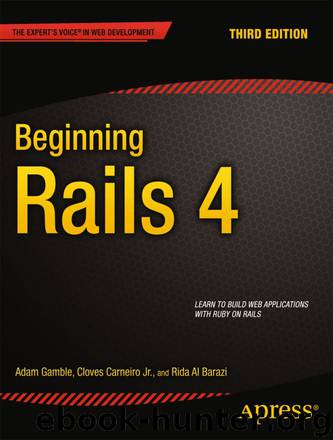Beginning Rails 4 by Adam Gamble & Cloves Carneiro Jr. & Rida Al Barazi

Author:Adam Gamble & Cloves Carneiro Jr. & Rida Al Barazi [Gamble, Adam & Carneiro, Cloves Jr. & Barazi, Rida Al]
Language: eng
Format: epub
Tags: Computers, Web, Web Programming, Programming Languages, Ruby
ISBN: 9781430260349
Publisher: Apress
Published: 2013-09-11T04:00:00+00:00
Named Routes
One of the coolest things about routing in Rails is a feature known as named routes. You can assign a name to a given route to make referring to it in code easier. You still define the route the same way as a regular route, but you need a new hash pair, where the key is :as and the value is the name of the route.
For example, let’s take the search route defined in the previous section and turn it into a named route:
get '/teams/search/:query' => 'teams#search', :as => 'search'
With this definition in place, Rails creates helper methods that allow you to reference this particular route using its name: search_url and search_path. The *_url variant returns a full URL including the protocol and hostname (http://example.com/teams/search), whereas the *_path variant returns just the path (/teams/search).
Later in this chapter, we’ll cover redirection methods and hyperlink-generation helpers. For now, note that you can use them with named routes:
link_to "Search", search_path
outputs
<a href="/teams/search">Search</a>
Named routes are shorter, DRYer, and impervious to changes made at the routing level. So if you change the controller name from teams to cities, you don’t need to update links that use the named route; for the unnamed version, you do.
Download
This site does not store any files on its server. We only index and link to content provided by other sites. Please contact the content providers to delete copyright contents if any and email us, we'll remove relevant links or contents immediately.
| Ajax | Assembly Language Programming |
| Borland Delphi | C & C++ |
| C# | CSS |
| Compiler Design | Compilers |
| DHTML | Debugging |
| Delphi | Fortran |
| Java | Lisp |
| Perl | Prolog |
| Python | RPG |
| Ruby | Swift |
| Visual Basic | XHTML |
| XML | XSL |
Deep Learning with Python by François Chollet(11923)
Hello! Python by Anthony Briggs(9388)
OCA Java SE 8 Programmer I Certification Guide by Mala Gupta(9354)
The Mikado Method by Ola Ellnestam Daniel Brolund(9321)
Dependency Injection in .NET by Mark Seemann(8867)
Algorithms of the Intelligent Web by Haralambos Marmanis;Dmitry Babenko(7861)
Test-Driven iOS Development with Swift 4 by Dominik Hauser(7353)
Grails in Action by Glen Smith Peter Ledbrook(7305)
The Well-Grounded Java Developer by Benjamin J. Evans Martijn Verburg(7130)
Secrets of the JavaScript Ninja by John Resig Bear Bibeault(5969)
Kotlin in Action by Dmitry Jemerov(4654)
Practical Vim (for Kathryn Amaral) by Drew Neil(3734)
Cracking the GRE Premium Edition with 6 Practice Tests, 2015 (Graduate School Test Preparation) by Princeton Review(3602)
Linux Device Driver Development Cookbook by Rodolfo Giometti(3453)
Learn Windows PowerShell in a Month of Lunches by Don Jones(3253)
Learning Java by Patrick Niemeyer & Daniel Leuck(2875)
Becoming a Dynamics 365 Finance and Supply Chain Solution Architect by Brent Dawson(2852)
Learning React: Functional Web Development with React and Redux by Banks Alex & Porcello Eve(2847)
Microservices with Go by Alexander Shuiskov(2648)
